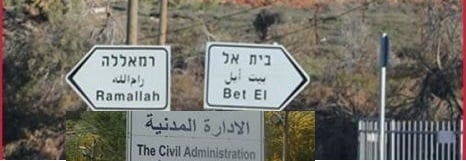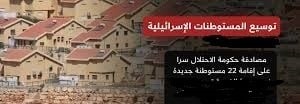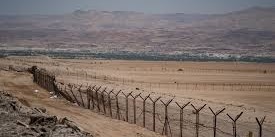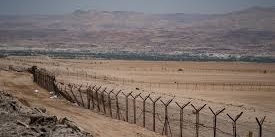By: Madeeha Al-A’raj
The national Bureau for Defending Land and Resisting Settlements stated in its latest weekly report , that during a meeting with a number of officials at the ‘Civil Administration’ last week, Israeli Finance Minister, and the Minister of Settlement at the Ministry of Army, Smotrich revealed new details on his plan to shut down the Civil Administration in the West Bank, adding that he discussed the issue with Israel’s PM Benjamin Netanyahu, expecting it to be carried out during the presidency of U.S. President-elect Donald Trump, and with the designated Israeli ambassador to Washington, Yehiel Light.Smotrich’s statement came in the context of a plan to dismantle the Palestinian National Authority and prevent it from becoming a Palestinian State. Dismantling the Civil Administration is a step towards dismantling the Authority.
With the establishment of the Palestinian Authority, the tasks of the Civil Administration were transferred to the ministries and bodies established by the Authority. Of course, it was agreed upon between the Palestinian and Israeli sides in the agreements signed between them that the Civil Administration, which was formed by the occupation following the Camp David Accords with Egypt, would be gradually dissolved by transferring its tasks to the jurisdiction of the ministries of the Palestinian Authority. What happened after that, wasn’t so, but rather reducing the number of employees, and keeping some sovereign powers in the hands of this administration, such as registering Palestinians, issuing identity cards, driving licenses, and other powers related to the population and land registry.
However, in 2000, that is, during and after the Al-Aqsa Intifada, Israeli interest in this administration returned and new recruitment processes began for its body and the restoration of more powers to the point of dealing directly with the Palestinians in various issues such as permits of various kinds, which were done through the Palestinian Authority, in addition to working on some projects that require Israeli permits in areas C that Israel has powers of administration and security.
But what is the story of this civil administration, which Smotrich threatens to dismantle in the context of implementing his plan to annex the West Bank to the occupying state. The story of this administration began on June 7, 1967, before the end of the June War, when the so-called commander of the Central Region in the occupation army issued Military Order No. 1, by virtue of which he became the de facto ruler of the occupied Palestinian territories and their inhabitants. The situation continued in this manner for years in the West Bank ‘Commander of the Central Region’ and in the Gaza Strip ‘Commander of the Southern Region’.
Though, this situation changed after the Camp David Accords with Egypt in 1981, when the Israeli cabinet issued a decision to establish the ‘Civil Administration for the Judea and Samaria Areas’ and its counterpart for the Gaza Strip. This resulted in a reorganization of the relationship between the Israeli occupation army and the Palestinian citizens under occupation with the aim of allowing the Palestinians to participate in managing their affairs in preparation for the establishment of a self-governing authority pursuant to resolution 947 of 1981, which ordered the establishment of the Civil Administration. It was decided to delegate representatives from the various Israeli ministries to head departments within the newly created administrative structure.
Thus, the Civil Administration was transformed into a ‘quasi-government’” concerned with the affairs of the occupied land, with its indigenous population and settlers as well, who continued to be dealt with according to Israeli civil laws, unlike the Palestinian citizens, to whom the laws of the military occupation continued to be applied., in the agreements signed between the Palestinian and Israeli sides, the military rule in the Palestinian territories occupied by the 1967 aggression was dissolved, and the Civil Administration continued with reduced powers. However, in 2012, Netanyahu’s second government revived the military rule of the West Bank through the law it issued, numbered 1650, through which a strong push was given to the Civil Administration and powers were given to the Israeli army in the areas of the Palestinian National Authority.
In 2018, a new development occurred in the status of this administration, and on October 31, 2018, the Knesset Subcommittee for ‘Judea and Samaria’s affairs’, in the West Bank, decided on a plan to expand the powers of the Civil Administration by adding 280 employees to this administration and expanding its powers and role at the expense of the powers and role of the Palestinian National Authority. In practice, one can say that the occupation authorities have evaded their obligations stipulated in the agreements signed between the Palestinian and Israeli parties, such that the Civil Administration has returned to becoming the de facto ruler in the occupied territories.
However, this situation doesn’t please the Minister of Settlement in the Ministry of the Occupation Army, Bezalel Smotrich, who sees the Civil Administration as one of the obstacles to the decisive plan, which he launched in 2017, which calls in one of its aspects to annex the largest possible area of the West Bank lands to the occupying state and to transform the remaining lands of the Palestinians in their homeland into municipal enclaves and village and local councils in which the Palestinians manage their daily affairs themselves.When Smotrich calls for dismantling and dissolving the Civil Administration, he knows exactly what the goal is, not only to seize land and transform it into a vital area for settlement activities without hindrance, but also to stifle the idea of an independent Palestinian state.
Unlike other Israeli politicians, Smotrich does not hide his program. He was clear when he promised his voters and supporters from the settlers and religious Zionists to dismantle the Civil Administration in his last Knesset election campaign, knowing that the Israeli security circles, ‘such as, the army and intelligence’, in addition to Israeli political parties oppose this for political reasons and prefer to maintain the status quo, which enables them to implement their settlement plans at a lower international cost. He was clear in his insistence on being the Minister of Settlement in the Ministry of Army. Since Smotrich assumed his responsibilities in the Ministry of Army, he has provided unprecedented services to the settlers and their plans. He continued this approach on every occasion, calling for imposing Israeli sovereignty over areas C at a minimum.
LastNov. he instructed his ministry to begin preparations to impose full Israeli sovereignty over the settlements in the West Bank. He said that he directed the Settlement Division in his ministry in the army and the Civil Administration to begin comprehensive work to prepare the necessary infrastructure to implement sovereignty. He stressed his intention to push through a government decision that the occupying state will work with the new administration of President Trump and the international community! to implement sovereignty and achieve American recognition. ‘Considering that the only way to remove the ‘threat’ of the establishment of a Palestinian state is to implement Israeli sovereignty over the settlements in Judea and Samaria’, which is the name many Israelis give to the West Bank. Is the Prime Minister of the occupation government, Benjamin Netanyahu, aware of all this and is he also pushing behind the scenes to translate Smotrich’s words into actions and plans on the ground? Sourcesconfirm that Netanyahu is the one who calls for that, not only in this government but in all the governments he headed.
Recently, on Nov. 12, the Israeli Broadcasting Authority quoted Netanyahu as stressing during closed-door talks the need to return the issue of annexing the West Bank to his government’s agenda when the US President takes office. The elected Donald Trump will assume his duties on Jan. 20, as quoted by those described as close to Netanyahu, that the plans to annex the West Bank to Israel already exist, and that Israel had been working on them since 2020 during Trump’s first presidential term, as part of what was known as the Century Deal. Smotrich isn’t content with calling for the dismantling of the Civil Administration as a tool to achieve his illusions of extending the sovereignty of the occupying state over the West Bank and at a minimum over areas C with the support of the new American Administration, but he is also working to advance the policy of expanding the area of control over Palestinian property in the occupied city of Jerusalem.
Within the contexrt, he recently decided to appoint an activist from the extreme right, Hananel Gurfinkel, as director of a unit in the ‘Custodian of Absentee Property’ in the Ministry of Finance, which is a new unit with great influence over Palestinian property in Jerusalem. Gurfinkel is known for having established an association to Judaize Jerusalem and called for the expulsion of Arab students from the Technion. During his previous position in the Ministry of Justice, he sought to assist settler associations in seizing Palestinian property and publicly called for the liquidation of what he called the ‘Arab occupation’ in East Jerusalem.
He sought to evict Jerusalemites in Sheikh Jarrah from their homes and property, claiming that they were built on lands allegedly owned by Jews. The appointment of this extreme right-winger as director of a unit in the ‘Custodian of Absentee Property’ in the Israeli Ministry of Finance is a major step to strengthen the occupation’s control over Palestinian property in occupied East Jerusalem, as part of a clear plan to Judaize the city, especially since the current land settlement in occupied Jerusalem is being used as a tool to identify and classify property with the aim of controlling it in various areas, such as, Beit Hanina, where many of its residents reside abroad.
In Jerusalem, the Local Planning and Construction Committee in the occupation municipality approved a recommendation to approve 3 plans to build towers in the settlements of Gilo, Katamon, and Gonenim, as part of the approved plans for a total of 740 settlement units, in addition to a series of government buildings, including a synagogue, public buildings, commercial areas, employment areas, and others. Work is underway to build a towering dam of high-rise settlement buildings on the borders adjacent to cities in the West Bank, especially in the south of occupied Jerusalem with Beit Jala.
According to the decision of the local committee, a plan was approved for a location on Haganat St. n 238 – the main street in the Gilo settlement – where 3 settlement towers consisting of 26 floors will be built: 22 residential floors above 4 basement floors for various uses, with an underground parking lot. As part of the project, which will cover 10.6 dunams, the committee proposes increasing the supply of settlement units in the plan area – from 65 existing settlement units to 340 new units, of which at least 20% are under construction. In addition, research is underway to allocate approximately 1,500 square meters of the plan area to public buildings for a group of daycare centers, kindergarten classes and a synagogue.
The plan also includes a commercial facade towards the light rail line with an area of approximately 1,800m2. This plan joins a series of municipal plans to build residential towers in the Gila Neighborhood in addition to a 37-story tower near the pioneering stadium ‘Teddy’ built on the lands of the evacuated Malha village. The second plan approved by the Planning Committee is located between St. Martin and Bar Yohai Streets, to build a total of 263 settlement units. Mayorof the occupied Jerusalem, Moshe Leon, said that the approved plans in the settlements of Gilo and Gonenim combine the construction of settlement complexes in central locations, along with the construction of public buildings, commercial and labor areas, and the development of advanced transportation infrastructure, and that work continues to renovate the old neighborhoods and work to transform Jerusalem into a modern, comfortable, and high-quality city that attracts new settlers.
As for expanding construction and settlement activities, it was announced that the occupation authorities will confiscate 24,000 dunams after classifying them as ‘state lands’. The Channel 14 Israel said that this announcement is a dramatic step that is expected to affect regional planning and change the face of the region. According to the aforementioned channel, the settlement of “Ma’ale Adumim” will be the biggest beneficiary of this step, with its expansion by an area of 2,600 dunams towards the south, which will create a settlement chain that reaches the settlement of ‘Kedar’. The settlement of “Migdal Oz,” between Hebron and Bethlehem, will double its area by adding 281 dunams, where 500 units will be built. Short-term residential. In the south of Hebron, the settlement of ‘Susya’ will expand its area by about 109 dunams, and industrial buildings will be built on it. In the Jordan Valley, the settlement of ‘Yefit’ will expand by an area of more than 20 thousand dunams, in a step is one of the largest in recent decades, since the Oslo Accords, regarding the Israeli seizure of Palestinian lands in the West Bank. It is noteworthy here that last year about 50,000 dunams were declared as state lands in a clear theft of Palestinian lands in favor of settlement expansion.
List of Israeli Assaults over the Last Week Documented by the National Bureau:
Jerusalem:
- Attacking citizens and merchants from Jerusalem in the Qattanin Market under the protection of the occupation police.
- Handing over a demolition order to Hashem Shakirat in Jabal al-Mukaber. The occupation municipality also handed to stop construction work orders to a number of the village’s homes and commercial establishments, and summonses to the municipality on.
- Handing over demolition orders and imposed various violations on the residents in the Issawiya town, while settlers seized a house belonging to the Ghaith family in the Batn al-Hawa Neighborhood in Silwan. Noting that the occupation court issued a decision last Sep. to evict the Ghaith family from their property in Silwan in favor of the settlers under the pretext of ‘their ownership of the land on which the building was built in addition to seizing a warehouse on the roof of Jamal Ghaith’s house.
Hebron:
- Assaulting citizen Ziad Shakhdam and his children, broke solar cells and the contents of the house, and stole dozens of sheep near the Buwaib area east of Yatta. Inthe Birin area east of Yatta, a group of settlers attacked the house of citizen Abu Nasser al-Azzamah and threatened to expel him from there. Settlers also expanded the ‘Susya settlement’, where new construction operations were observed at the site. In the Shaab al-Batm area in Masafer Yatta, the occupation forces prevented citizens from plowing and cultivating their lands, seized their agricultural equipment and forced them to leave after preventing them from cultivating their crops.
- Demolishing two 80m2 homes, a tent belonging to citizen Raed al-Amour, damaged water tanks and other facilities, uprooted more than 50 olive trees, and destroyed a fence and stone walls under the pretext that it was located within a so-called military zone in Khirbet al-Fakhit area.
- Demolishing the house of citizen Issa Jabreen Al-Daghmin, in addition to a water well and retaining walls surrounding the house in the Wadi al-Amairah area east of the As-Samu town,they also demolished a water well belonging to citizen Mah’d Al-Salawi, and bulldozed lands belonging to citizen Amin Al-Gharouz in the Wardan area in the Shuyukh Al-Arroub village.
Bethlehem:
- Burning a tent for housing in the village of Al-Minya, southeast of Bethlehem, in the ‘Wadi Al-Abyad area’ in the Al-Minya desert, belonging to citizen Ahmed Kamal Al-Tarwa. They also burned a tent containing fodder for raising livestock in a second attack.
- Surveyinglands and placing markers on them with the aim of expanding the settlement road from the ‘Etzion settlement’ towards the wilderness of al-Rashaydeh, reaching the Dead Sea road and expanding the Tekoa Street that leads to the Mazmuria and al-Nu’man checkpoint to the east in the Jourat al-Sham’a village,. This arbitrary measure will lead to the swallowing of dozens of agricultural dunams of the lands of Jourat al-Sham’a, al-Ma’sara, Marah Ma’ala, Tekoa, al-Halaqim, and Iftih.
- Seizing 94 dunams of agricultural land located behind the Apartheid Wall near the ‘tunnel’ area in Khallet Semaan – Beit Jala, leading to the occupied city of Jerusalem, with the aim of establishing a central settlement bus station for the occupation.
- Demolishing 2 houses and 3 cement walls under the pretext of building in Area C in the al-Malha area, in the Za’tara town.
Ramallah:
- Setting up tents near the Silwad town after storming the Burj area near the town and raising the occupation flags and banners with racist slogans written on them, noting that this area is considered an archaeological area and is frequented by settlers from time to time.
- Injuring 2 citizens in the Taybeh town after being attacked by settlers and were taken to the hospital for treatment, while others attacked citizen Saed Mustafa Diab by beating him and causing him moderate injuries, while he was working on his land in the Al-Khallah area, in the Turmusaya town, and damaged the tires of his vehicle.
Nablus:
- Attacking the southern area of Al-Dofuf in Qariot village, while the occupation bulldozers demolished homes, agricultural rooms, barracks and an electricity network that supplies Khirbet Al-Tawil, which is part of the lands of the Aqraba town, south of Nablus. The aforementioned area is systematically subjected to attacks by settlers and the occupation army with the aim of seizing more of its lands.
Salfeet:
- Issuing a decision to confiscate 432 dunums of lands from the Az-Zawiya and Rafat towns, behind the apartheid wall to expand the stone crusher that has been built on the lands of Az-Zawiya since 1982 that works for the benefit of the settlements and is affiliated with several European companies, including the German Heidelberg, Henson, and Israeli concrete and asphalt companies.
- Cutting down 15 olive trees in the area of Hariqa Abdullah, northeast of the village of Yasuf,belonging to citizen Jihad Saleh Hussein. They also vandalized a well in the area of Hariqa Abdul Razek, belonging to citizen Zuhair Jamil Abdul Razek, east of the town.\
- Destroying an agricultural room, belonging to citizen Faeq Abdul Rahim Rizk Allah, in the village of Farkha, and broke and stole its contents.
- Handing over 2 notices to stop work and construction on a house under construction in the Al-Nusbah area east of the Yasuf village, and demolished two agricultural rooms belonging to citizens Ahmed Rashid Nimr and Rabah Ayoub, and 2 wells for collecting rainwater, belonging to citizens Ahmed Ali Ahmed and Daoud Al-Deek in the Banat Ber area in the Kafr Al-Deek town.
Jordan Valley:
- Bulldozing lands in the Al-Jiftlik village in the Al-Makhrouq area, estimated at more than 100 dunums in preparation for seizing them and planting them with grape trees. Preventing young man Moh’d Salah Daraghmeh from grazing his livestock near his relatives’ tents in Al-Farisiya in the northern Jordan Valley and expelled him from the there.
- Erecting barbed wire fences and signs near citizens’ homes in Ein Al-Hilweh in the northern Jordan Valley, while others drew symbols of the occupation in various areas of the Jericho and Jordan Valley Governorate, including a house in Al-Jiftlik and a sidewalk in Al-Mu’arjat, in addition to drawing ‘The Star of David’ near the Auja Spring, and the attacks extended to the Al-Ma’rajat area, where the flag of Israel was painted.
 المكتب الوطني للدفاع عن الارض ومقاومة الاستيطان منظمة التحرير الفلسطينية
المكتب الوطني للدفاع عن الارض ومقاومة الاستيطان منظمة التحرير الفلسطينية




